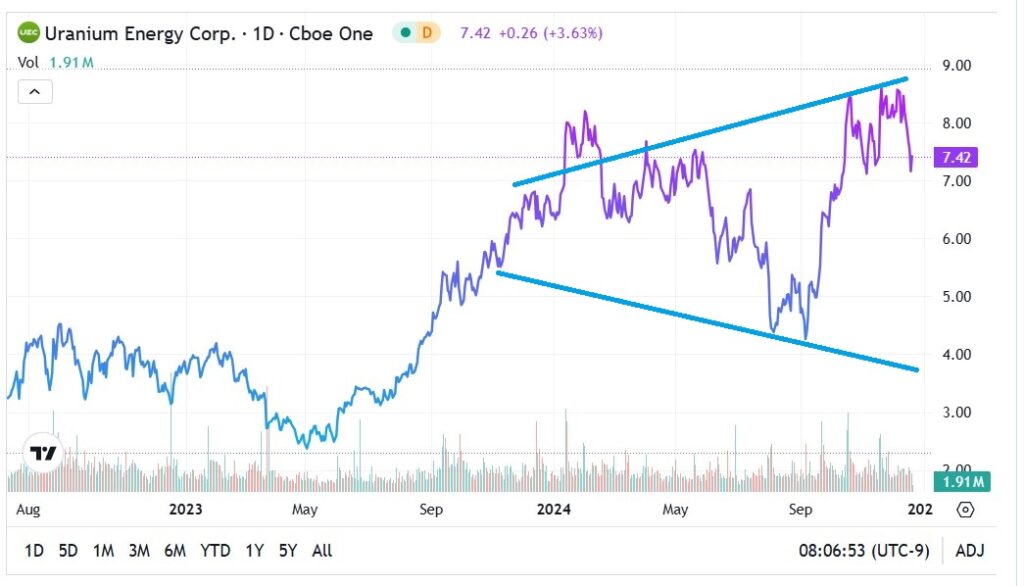Zinger Key Points
- While demand for Uranium Energy’s namesake asset is soaring thanks to tech, political headwinds pose concerns.
- Given the narrative’s complexity, options traders can deploy a directionally neutral strategy called the long straddle.
- Don't face extreme market conditions unprepared. Get the professional edge with Benzinga Pro's exclusive alerts, news advantage, and volatility tools at 60% off today.
On paper, the underlying commodity of Uranium Energy Corp. UEC appears to enjoy a northbound framework. In particular, the market for generative artificial intelligence may spark a $1 trillion impact on the U.S. economy within the next 10 years. However, AI isn't free in terms of energy consumption, thus adding fundamental relevance to UEC stock.
What's more, according to the World Economic Forum, the present energy consumption of machine intelligence is but a fraction of the broader tech ecosystem's power expenditure. With the deployment of data centers, blockchain mining and other energy-consumptive innovations, the nuclear fuel industry may benefit from a net bullish backdrop.
Nevertheless, while UEC stock has swung higher over the past 52 weeks, the journey hasn't been a smooth one. From a technical standpoint, since the final months of 2023, UEC appears to be in the middle of forming a broadening top pattern. Also known as a megaphone pattern, this price action features higher highs and lower lows — a sort of horizontal pyramid.

Regarding the news cycle, President-elect Donald Trump's proposed tariffs on Canada could have significant economic implications. As it relates to UEC stock, Canadian export taxes on uranium could devastate U.S. nuclear energy producers. Currently, Canada supplies about a quarter of the uranium used in U.S. nuclear reactors.
Also Read: EXCLUSIVE: Nvidia, Broadcom Tipped To Dominate AI Compute Wave By Kurv CEO
Taking the Straddle Long with UEC Stock Options
Based on the lack of both fundamental and technical clarity of where UEC stock may head over the short to intermediate term, placing a directional wager might not be the most prudent idea. Instead, speculators may opt to consider a directionally neutral strategy. One of the simplest but powerful ideas is to deploy a long straddle.
Falling under the category of multi-leg options strategies, the straddle doesn't need much explanation because it's so intuitive. For a given options chain (i.e. same expiration date), the trader buys a call option and a put option of the same strike price. Essentially, the trader is paying a premium to "attack" the possibility of both outcomes rather than choosing between them.
Of course, there's no such thing as a free lunch, especially on Wall Street. For a purely directional wager — such as buying just a call or a put — the trader pays one premium. To break even, the target security must hit the strike price plus the premium paid. By logical deduction, to break even with a long straddle, the strike price must either rise above or fall below the strike price by the premium paid of both the call and put.
On the positive end, the losses of a long straddle are limited to the total debit paid to enter the trade. Moreover, the upside is theoretically unlimited. True, if the security moves extremely, either the call or the put will expire worthless. However, the trader is banking on the in-the-money (ITM) option to reap the rewards.
Targeting the $7 February Long Straddle
At the time of writing, traders may want to consider the $7 long straddle in UEC stock for the options chain expiring Feb. 21, 2025. This trade provides 64 calendar days to expiration for UEC to break above either the upper or lower profitability thresholds. Based on current ask prices, the upper breakeven point stands at $8.50 while the lower breakeven point sits at $5.50.
These price targets appear to be realistic propositions based on stochastic calculations. Right now, the average implied volatility of the February options chain clocks in at approximately 58%. By multiplying this figure by the UEC stock price and its time decay adjustment (or the square root of the calendar days to expiration divided by 365 days), traders can "reverse" engineer the market's unit price expectation of volatility.
The result of this calculation is approximately $1.79. Added to and subtracted from the current share price, the market expects UEC stock to either move to $9.16 or $5.58 by expiration. Obviously, the call-side wager is much likelier to materialize. However, this long straddle also buys "protection" in case of severely volatile movement.
Keep in mind that in August and September, UEC stock had fallen below the $5 level. Ultimately, this long straddle naturally seeks to hit the upper price target. Still, the strategy provides just-in-case coverage should something terribly negative materialize.
Read Next:
Photo: Shutterstock
Edge Rankings
Price Trend
© 2025 Benzinga.com. Benzinga does not provide investment advice. All rights reserved.